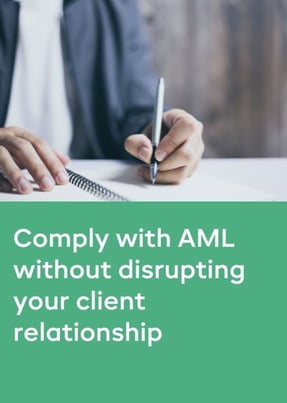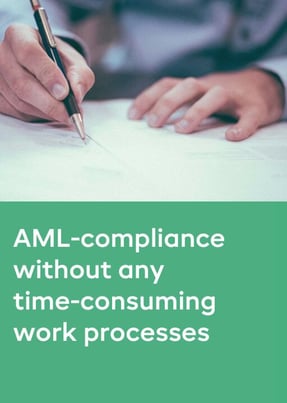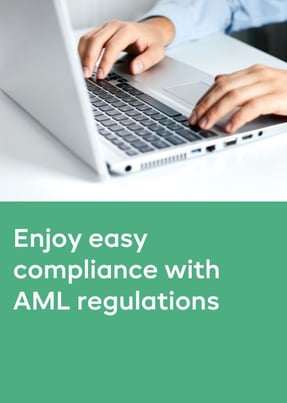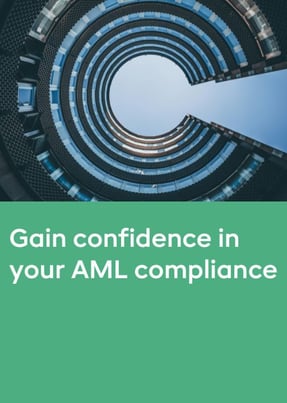- Products
- RegLab for ...
- Knowledge centre
Download the AML glossary >
 Discover the essential AML compliance terminology and gain instant access to a comprehensive guide
Discover the essential AML compliance terminology and gain instant access to a comprehensive guide - The company
Working at RegLab >
Join RegLab as the new Product Owner of our software tool and change the way the legal community approaches anti-money laundering.
There may not be any vacancies that perfectly match your profile, but that does not mean there is no room for someone who can improve RegLab.
- Book a demo
AMLR and AMLA
The launch of the Anti-Money Laundering Regulation (AMLR) and the Anti-Money Laundering Authority (AMLA) causes some changes to how you comply with money laundering prevention. The new legislation replaces the directives with a swiftly applicable regulation that applies in all EU member states. In this article, we explain what the arrival of the AMLR and AMLA will mean for you.
What is the AMLR?
The AMLR (Anti-Money Laundering Regulation) is the new European regulation that largely replaces the existing anti-money laundering directives. It marks an important change of direction: instead of separate directives (such as AMLD5 or AMLD6), there is one uniform set of rules that applies directly in all EU member states.
From 10 July 2027, all member states, must fully comply with the new regulations. AML-compliant firms need to review their policies and processes to be ready for the unified European rules.
AMLD, national legislation, or AMLR?
However, that room for national interpretation disappears under the AMLR, which you will have to deal with from mid-2027. The new regulation ensures that every EU member state has to comply with exactly the same regulations. Whereas directives first had to be transposed into national legislation by member states, the regulation applies directly in every member state. This requires a critical look at existing procedures, but also offers some advantages:
- It creates clarity
- It prevents differences of interpretation
- It gives less room for exceptions
- It leads to more unity in the EU
What is the AMLA?
Whereas the AMLR sets out the substantive obligations, the AMLA will enforce them within the EU.
The AMLA (Anti-Money Laundering Authority) is a new initiative of the European Union. Its main objective is to ensure that anti-money laundering and terrorist financing (AML/CFT) rules are applied in a consistent and high-quality manner across EU member states. The organisation does this partly by supporting national FIUs and conducting its own supervision. In addition, AMLA encourages cooperation and mutual support between member states.
Important to know: national supervisors remain responsible for most of the supervision. The AMLA only directly supervises a limited number of cross-border entities with a heightened risk profile.
AMLA's core tasks:
- Developing and implementing AML/CFT regulations
- Active enforcement and sanctioning
- Awareness raising and education
- Strengthening international cooperation
- Research and analysis
- Identifying and combating terrorist financing
When will the AMLA be active?
By 2024, AMLA will be legally established and a year later it will open its new headquarters in Frankfurt, Germany. At the time of writing (2025), AMLA is working to expand its staff and further develop implementing rules. It is expected to be fully operational in 2028 and direct supervision will start with it.
What will the AMLA do?
The preamble to the AMLR (REGULATION (EU) 2024/1624) sets out various tasks and responsibilities for the AMLA. Among other things, it will:
- Develop guidelines on the minimum requirements for the content of the firm-wide risk assessment and additional sources of information (Preamble, paragraph 31, REGULATION (EU) 2024/1624).
- Ensure proportionate monitoring of client relationships and transactions based on risk profiles (Preamble, paragraph 72, REGULATION (EU) 2024/1624).
- Develop technical standards for required client information at onboarding and monitoring depending on the level of risk associated with each client (Preamble, paragraph 74, REGULATION (EU) 2024/1624).
- Identify emerging risks and money laundering typologies outside the EU, monitor their evolution and provide appropriate guidance (Preamble, paragraph 89, REGULATION (EU) 2024/1624).
- Establish guidelines for assessing risks associated with specific categories of PEPs (Preamble, paragraph 90, REGULATION (EU) 2024/1624).
- Develop an EU-wide uniform suspicious transaction reporting format (Preamble, paragraph 139, REGULATION (EU) 2024/1624).
Themed file: fully prepared for the supervisor’s audit
This article is part of a series of articles and downloads that will help you get ready for a supervisor visit. The content is based on the frequently asked questions of a supervisor during an audit. Do you want to be 100% AML proof and ready for a visit from the regulator? You can find all frequently asked questions in our knowledge centre.
Knowledge centre
Download the checklist: "Compliance Maturity Check"
Gain insight into the maturity level of your compliance and discover areas for improvement.





